Glucometry: measurement of capillary blood glucose levels using a portable glucometer and interpretation of results.
Description of the clinical situation:
You are a general practitioner. A patient with a history of diabetes mellitus has come to see you. Teach the patient how to use an individual glucometer. Conduct a test and interpret the results.
The equipment needed to perform this skill:
glucometer
code plate (can be inserted into the glucometer in advance)
test strips in a package (test strip code is indicated on the package)
puncture device
sterile lancet
skin antiseptic
MI disinfection container
brush phantom
laptop
virtual simulator “Glucometer”
The order in which the skill is performed:
Preparatory phase:
introduce yourself
Identify the patient by asking him/her to give his/her last name, first name, middle name, date of birth.
Explain the purpose and progress of the procedure
obtain verbal informed consent
Assess the patient's condition
hygienically antiseptic hands, wear non-sterile gloves.
Main Stage:
- Insert the code plate (the plate may already be inserted)
- Prepare the glucometer for use:
- take the device off
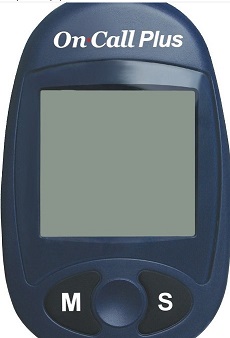
- take a package of test strips
- Take out one test strip and insert it as far as it will go into the glucometer receiver with the uncolored side (the side with the contact strips opposite the contact window).
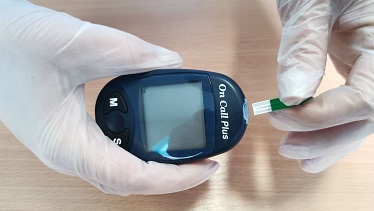
- insert the test strip all the way into the glucometer receiver with the device turned off
- Make sure the glucometer is ready for use
- note the presence of the code number (in the center of the screen)
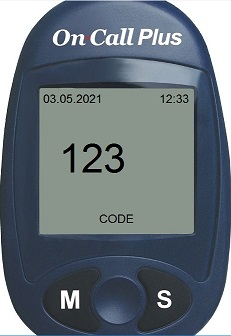
- make sure that the code number displayed on the glucometer screen matches the code number on the test strip package.
- make sure the glucometer screen has a flashing schematic image of the test strip and blood drop.
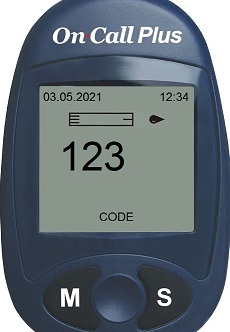
- Prepare the lancet device:
- Unscrew and remove the cap of the lancet device
- Insert the lancet into the holder as far as possible until it is firmly seated
- Unscrew the protective disk from the lancet
- Replace and tighten the cap until it clicks into place, so that the lock indicator is at the rightmost position
- Hold the cap in the well area and select the piercing depth by rotating the piercing depth control to either side so that the arrow on the cap points to the desired depth value
- 1 and 2 are for delicate skin
- 3 - for normal skin
- 4 and 5 - for rough or thick skin
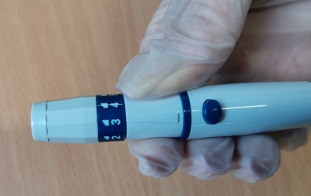
Pull back the spring cocking knob until it clicks into place
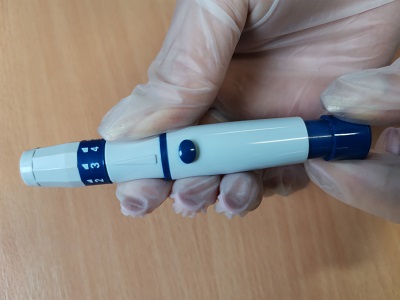
Get a drop of blood
-
- Treat the pad of your finger with antiseptic
- Place the lancet device on the pad of your finger and puncture it
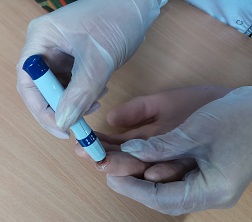
-
- Pull the lancet device away from the finger
- With a sterile cotton ball, remove the first drop of blood
- Dispose of the balloon in the appropriate container
- Gently squeeze the puncture area to obtain another drop of blood
- Apply a drop of blood to the contact window of the test strip
- Bring the test strip inserted in the device to a drop of blood
- Gently touch the blood drop once on the side (end of the test strip) until the contact window is filled with blood due to adsorption; note: applying a drop of blood from above and touching the blood drop again is a gross error.
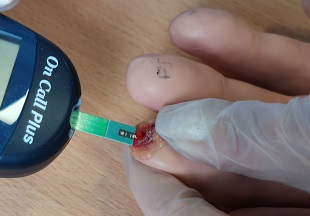
- make sure that the test box is filled in completely and correctly: the glucometer screen will automatically start counting down the time until the result is obtained.
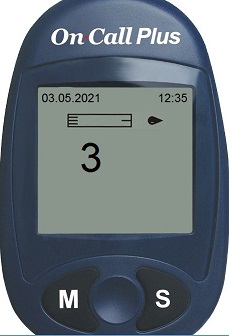
- Familiarize yourself with the result of the study:
- if there is a digital result on the display - read the result of the examination and interpret it
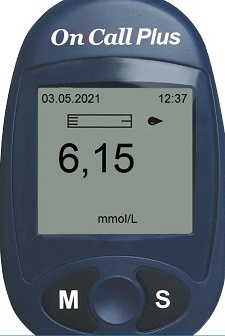
-
- if the display shows the following errors: LO (low glucose concentration less than 1.1 mmol/L) or HI (high glucose concentration more than 33.3 mmol/L), remove the strip, take another and repeat the test.
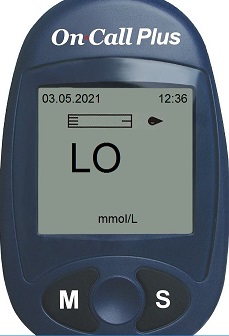
- Interpret the result of the examination and give recommendations to the patient according to these results
- norm (fasting glucose norm at rest is 3.88-5.55 mmol/l, glucose norm 2 hours after a meal is less than 7.8 mmol/l)
- hyperglycemia
- is detected for the first time - it is necessary to conduct additional examination (blood test for glycated hemoglobin, repeated control of blood glucose on an empty stomach and 2 hours after a meal);
- in case of prescribed treatment - adjustment of treatment
- hypoglycemia:
- If the patient is conscious and can eat on his/her own, he/she should immediately ingest 20 g of easily digestible carbohydrates, preferably in liquid form (4-5 pieces of sugar dissolved in water or 200 ml of any sweet drink, juice or milk). Usually after ingestion of easily digestible carbohydrates neurological symptoms disappear within 5-10 min. After 15 min, glycemia should be rechecked. If the blood glucose level still does not exceed 3.5 mmol/L, the above described intake of digestible carbohydrates should be repeated. If the glycemia has become higher than 3.5 mmol/L, the patient should be offered a normal meal.
- if against the background of hypoglycemia the patient is unable to eat independently, 60 ml of 40% glucose solution should be injected intravenously.
Final Step:
- Turn off the instrument by removing the test strip from the instrument
- Dispose of the used test strip in the “MI Disinfection” container
- Remove the lancet by first removing the cap of the device
- Dispose of the lancet in the “MI Disinfection” container.
- Remove gloves and place them in the container: “Disinfection of dressings, PPE”.
- Perform hygienic hand sanitization
- Instruct the patient to make appropriate diary entries